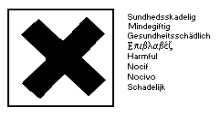Permethrin
Permethrin (Biothrin, 3-Phenoxybenzyl(1RS)-cis,trans-3-(2,2-dichlorovinyl)-2,2-dimethylcyclopropanecarboxylate, CAS#52645-53-1) is a common synthetic chemical, widely used as an insecticide, acaricide, and insect repellent. It belongs to the family of synthetic chemicals called pyrethroids and functions as a neurotoxin, affecting neuron membranes by prolonging sodium channel activation. It is not known to rapidly harm most mammals or birds, but is dangerously toxic to cats and fish. In general, it has a low mammalian toxicity and is poorly absorbed by skin.
Uses
Permethrin is used:
as an insecticide in agriculture:
to protect crops in agriculture;
to kill livestock parasites;
for industrial/domestic insect control;
as an insect repellent or insect screen:
in timber treatment;
as a personal protective measure (cloth impregnant, used primarily for US military uniforms and mosquito nets);
in pet flea preventative collars or treatment.
In agriculture, permethrin is mainly used on cotton, wheat, maize, and alfalfa crops. Its use is controversial because, as a broad-spectrum chemical, it kills indiscriminately; as well as the intended pests, it can harm beneficial insects including honey bees, and aquatic life. Permethrin kills ticks on contact with treated clothing. A method of reducing deer tick populations by treating rodent vectors involves stuffing biodegradable cardboard tubes with permethrin-treated cotton. Mice collect the cotton for lining their nests. Permethrin on the cotton instantly kills any immature ticks that are feeding on the mice. It is important to put the tubes where mice will find them, such as in dense, dark brush, or at the base of a log; mice are unlikely to gather cotton from an open lawn. Permethrin is used in tropical areas to prevent mosquito-borne disease such as dengue fever and malaria. Mosquito nets used to cover beds may be treated with a solution of permethrin. This increases the effectiveness of the bed net by killing parasitic insects before they are able to find gaps or holes in the net. Military personnel training in malaria-endemic areas may be instructed to treat their uniforms with permethrin, as well. An application should last several washes.
Permethrin is used on humans to eradicate parasites such as head lice, mites responsible for scabies and pest repellent clothing treatment; the common prescription is Permethrin with 5% concentration for scabies, and OTC (over-the-counter) treatment for head lice/crabs is usually permethrin with 1% concentration. Pharmaceutical grade permethrin 99% is differentiated from pesticide grade 94% by a higher purity, well specified impurities and lower content of the toxic CIS component at 25% as opposed to 40% in the pesticide grade. It is offered commercially by companies like VAV Life Sciences, Dow Chemicals etc. and used extensively by agencies working in forest areas such as the US Army. Permethrin is also used in industrial and domestic settings to control pests such as ants and termites.
In order to better protect soldiers from the risk and annoyance of biting insects, the US Army is fielding uniforms factory treated with permethrin.
Package & Transport
Package Size: N.W: 20/25 Kg G.W: 24/29 Kg;
UN Number: 3352
Hazard Class: 6.1
Notice
1. Avoid mixture with food and forage, and avoid reach of children.
2. Use respirator and glove when handling, clean completely with soap and water when splashed into skin.
3. Destroy and bury waste drum or dip it into alkali liquid for several days for recycling uses.
4. Storage in dry, cold area and avoid light.
Permethrin
 |
|
| Molecular Formula | C21H20Cl2O3 |
| Molar Mass | 391.281 g/mol |
IUPAC Name
Identifiers
SMILES[hide]
InChI[hide]
Key: RLLPVAHGXHCWKJ-UHFFFAOYSA-N
InChI=1/C21H20Cl2O3/c1-21(2)17(12-18(22)23)19(21)20(24)25-13-14-7-6-10-16(11-14)26-15-8-4-3-5-9-15/h3-12,17,19H,13H2,1-2H3
Key: RLLPVAHGXHCWKJ-UHFFFAOYAS
Properties
| Appearance | |
| Density | 1.19 g/cm3 (25 ℃) |
| Melting point | 34 ℃ |
| Boiling point | 200 ℃ |
| Vapour pressure | ×10-4mmHg at 25℃ |
| Solubility in water | 5.5 x 10-3 ppm |
Hazards[hide]
| MSDS | Permethrin_MSDS.pdf |
| R-phrases | R20/22, R43, R50/53 |
| S-phrases | S2, S13, S24, S36/37/39, S60, S61 |
| Main Hazards | Xn, N |
| Warning Label |

|
| Flash Point | 87℃ |
Supplementary data[hide]
| Spectral Data | UV, IR, NMR, MS |
| TDS | Permethrin_TDS.pdf |
| Others Data | Analysis_report; Toxic_report; Etoxic_report; Pesticide_registration; Bioeffect_report, etc. |

 English
English 中文简体
中文简体




 Arabic
Arabic  French
French  Italian
Italian  German
German  Japanese
Japanese  Korean
Korean  Portuguese
Portuguese  Russian
Russian  Spanish
Spanish 